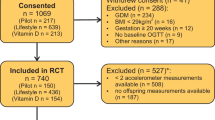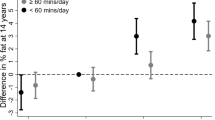Abstract
Background
Rodent models suggest that in utero exposure to under and overnutrition programs offspring physical activity (PA) behaviors. Such nexus has not been established in humans. This study evaluated the association of early pregnancy maternal adiposity with offspring PA at age 2 years (2-yo-PA) taking into consideration prenatal and postnatal factors.
Methods
Women (n = 153) were enrolled early in pregnancy (<10 weeks). At enrollment, maternal adiposity [air displacement plethysmography, fat mass index (FMI, kg/m2)] and PA (accelerometers, activity counts) were measured, and age, race, and education self-reported. Gestational weight gain was measured at the research facility. Offspring birthweight and sex were self-reported. At age 2 years, parental feeding practices (child feeding questionnaire) were assessed, whereas anthropometrics (length and weight) and physical activity (accelerometers) were objectively measured. Offspring body mass index z-scores were calculated. Generalized linear regression analysis modeled the association of maternal FMI and 2-yo-PA [average activity counts (AC)4/day].
Results
In bivariate associations, 2-yo-PA did not associate with maternal FMI (β = −0.22, CI = −0.73 to 0.29, p = 0.398). However, maternal FMI interacted with offspring sex in association with 2-yo-PA. Specifically, 2-yo-PA was lower in girls (β = −1.14, CI = −2.1 to −0.18, p = 0.02) compared to boys when maternal FMI was ≥7 kg/m2. When stratified by sex, 2-yo-PA of girls negatively associated with maternal FMI (β = −0.82, CI = −1.43 to 0.29, p = 0.009) while no association was found between maternal FMI and boy’s PA (β = 0.32, CI = −0.38 to 1.01, p = 0.376).
Conclusions
The association of 2-yo-PA and early pregnancy maternal adiposity was modified by offspring sex. Offspring’s physical activity decreased with increasing early pregnancy adiposity maternal in girls but not boys in second parity dyads.
This is a preview of subscription content, access via your institution
Access options
Subscribe to this journal
Receive 12 print issues and online access
$259.00 per year
only $21.58 per issue
Buy this article
- Purchase on Springer Link
- Instant access to full article PDF
Prices may be subject to local taxes which are calculated during checkout


Similar content being viewed by others
Data availability
The datasets generated during and/or analyzed during the current study are available from the corresponding author on reasonable request.
References
Ravelli AC, van der Meulen JH, Michels RP, Osmond C, Barker DJ, Hales CN, et al. Glucose tolerance in adults after prenatal exposure to famine. Lancet. 1998;351:173–7.
Ravelli GP, Stein ZA, Susser MW. Obesity in young men after famine exposure in utero and early infancy. N Engl J Med. 1976;295:349–53.
Vahratian A. Prevalence of overweight and obesity among women of childbearing age: results from the 2002 National Survey of Family Growth. Maternal Child Health J. 2009;13:268–73.
Diaz EC, Cleves MA, DiCarlo M, Sobik SR, Ruebel ML, Thakali KM, et al. Parental adiposity differentially associates with newborn body composition. Pediatr Obes. 2020;15:e12596.
Heard-Lipsmeyer ME, Diaz EC, Sims CR, Sobik SR, Ruebel ML, Thakali KM, et al. Maternal adiposity is associated with fat mass accretion in female but not male offspring during the first 2 years of life. Obesity (Silver Spring). 2020;28:624–30.
Whitaker RC. Predicting preschooler obesity at birth: the role of maternal obesity in early pregnancy. Pediatrics. 2004;114:e29–36.
Cunha Fda S, Dalle Molle R, Portella AK, Benetti Cda S, Noschang C, Goldani MZ, et al. Both food restriction and high-fat diet during gestation induce low birth weight and altered physical activity in adult rat offspring: the “Similarities in the Inequalities” model. PLoS One. 2015;10:e0118586.
Johnson SA, Javurek AB, Painter MS, Murphy CR, Conard CM, Gant KL, et al. Effects of a maternal high-fat diet on offspring behavioral and metabolic parameters in a rodent model. J Dev Orig Health Dis. 2017;8:75–88.
Wasenius NS, Grattan KP, Harvey ALJ, Barrowman N, Goldfield GS, Adamo KB. Maternal gestational weight gain and objectively measured physical activity among offspring. PloS One. 2017;12:e0180249.
Gilmore LA, Redman LM. Weight gain in pregnancy and application of the 2009 IOM guidelines: toward a uniform approach. Obesity (Silver Spring). 2015;23:507–11.
Henriksson P, Lof M, Forsum E. Assessment and prediction of thoracic gas volume in pregnant women: an evaluation in relation to body composition assessment using air displacement plethysmography. Br J Nutr. 2013;109:111–7.
Toftager M, Kristensen PL, Oliver M, Duncan S, Christiansen LB, Boyle E, et al. Accelerometer data reduction in adolescents: effects on sample retention and bias. Int J Behav Nutr Phys Act. 2013;10:140.
Wolff-Hughes DL, McClain JJ, Dodd KW, Berrigan D, Troiano RP. Number of accelerometer monitoring days needed for stable group-level estimates of activity. Physiol Meas. 2016;37:1447–55.
International Fetal and Newborn Growth Consortium for the 21st Century. Standards and Tools—Newborn size [Available from: https://intergrowth21.tghn.org/standards-tools/.
Birch LL, Fisher JO, Grimm-Thomas K, Markey CN, Sawyer R, Johnson SL. Confirmatory factor analysis of the Child Feeding Questionnaire: a measure of parental attitudes, beliefs and practices about child feeding and obesity proneness. Appetite. 2001;36:201–10.
Canadian Pediatric Endocrine Group. R Shiny Apps from CPEG-GCEP [Available from: https://www.cpeg-gcep.net/.
McVeigh JA, Winkler EA, Healy GN, Slater J, Eastwood PR, Straker LM. Validity of an automated algorithm to identify waking and in-bed wear time in hip-worn accelerometer data collected with a 24 h wear protocol in young adults. Physiol Meas. 2016;37:1636–52.
Howie EK, Nelson A, McVeigh JA, Andres A. Physical activity, sedentary and sleep phenotypes in women during the first trimester of pregnancy. Matern Child Health J. 2023;27:1834–45.
Bursac Z, Gauss CH, Williams DK, Hosmer DW. Purposeful selection of variables in logistic regression. Source Code Biol Med. 2008;3:17.
Aiken CE, Ozanne SE. Sex differences in developmental programming models. Reproduction. 2013;145:R1–13.
Zhu S, Eclarinal J, Baker MS, Li G, Waterland RA. Developmental programming of energy balance regulation: is physical activity more ‘programmable’ than food intake? Proc Nutr Soc. 2016;75:73–7.
Labayen I, Ruiz JR, Ortega FB, Loit HM, Harro J, Villa I, et al. Exclusive breastfeeding duration and cardiorespiratory fitness in children and adolescents. Am J Clin Nutr. 2012;95:498–505.
Verloigne M, Van Lippevelde W, Maes L, Yildirim M, Chinapaw M, Manios Y, et al. Levels of physical activity and sedentary time among 10- to 12-year-old boys and girls across 5 European countries using accelerometers: an observational study within the ENERGY-project. Int J Behav Nutr Phys Act. 2012;9:34.
Riddoch CJ, Bo Andersen L, Wedderkopp N, Harro M, Klasson-Heggebo L, Sardinha LB, et al. Physical activity levels and patterns of 9- and 15-yr-old European children. Med Sci Sports Exerc. 2004;36:86–92.
Ekelund U, Luan J, Sherar LB, Esliger DW, Griew P, Cooper A, et al. Moderate to vigorous physical activity and sedentary time and cardiometabolic risk factors in children and adolescents. JAMA. 2012;307:704–12.
Hager ER, Gormley CE, Latta LW, Treuth MS, Caulfield LE, Black MM. Toddler physical activity study: laboratory and community studies to evaluate accelerometer validity and correlates. BMC Public Health. 2016;16:936.
Hnatiuk J, Ridgers ND, Salmon J, Campbell K, McCallum Z, Hesketh K. Physical activity levels and patterns of 19-month-old children. Med Sci Sports Exerc. 2012;44:1715–20.
Diaz EC, Williams DK, Cotter M, Sims CR, Wolfe RR, Andres A, et al. Breastfeeding duration modifies the association between maternal weight status and offspring dietary palmitate oxidation. Am J Clin Nutr. 2022;116:404–14.
Garland T Jr., Schutz H, Chappell MA, Keeney BK, Meek TH, Copes LE, et al. The biological control of voluntary exercise, spontaneous physical activity and daily energy expenditure in relation to obesity: human and rodent perspectives. J Exp Biol. 2011;214:206–29.
Eclarinal JD, Zhu S, Baker MS, Piyarathna DB, Coarfa C, Fiorotto ML, et al. Maternal exercise during pregnancy promotes physical activity in adult offspring. FASEB J. 2016;30:2541–8.
Mattocks C, Deere K, Leary S, Ness A, Tilling K, Blair SN, et al. Early life determinants of physical activity in 11 to 12 year olds: cohort study. Br J Sports Med. 2008;42:721–4.
Acknowledgements
The authors thank the children and their parents participating in this study. We thank the clinical team from the Arkansas Children’s Nutrition Center.
Funding
USDA-ARS Project 6026-51000-012-06 S. ECD, EKH, and EB are partially supported by the Center for Childhood Obesity Prevention (NIH-NIGMS award 5P20GM109096). EB is partially supported by the UAMS-TRI (NCATS UL1-TR003107 & KL2 TR003108). AA is partially supported by NIH UG1 0D024945, NIH U01 DA055352, NIH R01 ES032176 and NIH R01 HD099099.
Author information
Authors and Affiliations
Contributions
ECD, EB, and AA were responsible for conception and design of study. ECD performed literature search. ECD, KW, EKH, EB, and AA analyzed the data. ECD, KW, EKH, EB, and AA interpreted the data. ECD prepared the manuscript. ECD, KW, EKH, EB, and AA critically revised and approved the final version of the manuscript.
Corresponding author
Ethics declarations
Competing interests
The authors declare no competing interests.
Additional information
Publisher’s note Springer Nature remains neutral with regard to jurisdictional claims in published maps and institutional affiliations.
Rights and permissions
Springer Nature or its licensor (e.g. a society or other partner) holds exclusive rights to this article under a publishing agreement with the author(s) or other rightsholder(s); author self-archiving of the accepted manuscript version of this article is solely governed by the terms of such publishing agreement and applicable law.
About this article
Cite this article
Diaz, E.C., Williams, D.K., Howie, E.K. et al. Offspring sex modifies the association between early-pregnancy adiposity and 2-year-old physical activity—The Glowing Study. Int J Obes 48, 542–549 (2024). https://doi.org/10.1038/s41366-023-01446-7
Received:
Revised:
Accepted:
Published:
Issue Date:
DOI: https://doi.org/10.1038/s41366-023-01446-7



